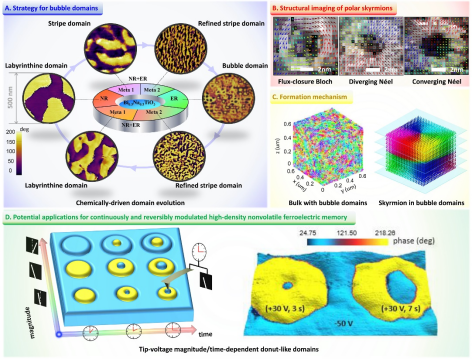Professor Jiagang Wu's team of the Department of Materials Science has made important progress in domain structure control of lead-free sodium bismuth titanate based relaxor ferroelectric ceramics. This work provides a new idea for the study of topological domains in bulk ferroelectrics. The research results are published in Nature Communication sunder the title of "Nanoscale Bubble Domains with Polar Topologies in Bulk Ferroelectrics". Jie Yin, an SCU doctoral student, and Hongxiang Zong of Xi’an Jiaotong University are the first authors; the corresponding authors are Jiagang Wu, Haijun Wu and Stephen J. Pennycook.
“Theoretical and experimental findings suggest that kinetic constraint possibly exists in systems that exhibit two or more distinct modulated phases, and therefore should also apply to bulk materials15. Relaxor ferroelectrics, with decoupled dipoles (of multiple symmetries) naturally coexisting in local regions16, may just satisfy the requirement of this kinetic constraint. In their free energy expansion, the high-order gradient terms could provide a negative wall energy, which could drive modulations of polarization vectors as well as domain configurations.---” (Introduction)“---Here, in any bulk material, we achieve self-confined bubble domains with multiple polar topologies in bulk Bi0.5Na0.5TiO3 ferroelectrics, especially skyrmions, as validated by direct Z-contrast imaging. This phenomenon is driven by the interplay of bulk, elastic and electrostatic energies of coexisting modulated phases with strong and weak spontaneous polarizations. We demonstrate reversable and tip-voltage magnitude/time-dependent donut-like domain morphology evolution towards continuously and reversibly modulated high-density nonvolatile ferroelectric memories.” (Abstract)

A: Observation of bubble domains in bulk ferroelectrics.B. Structural imaging of polar skyrmions; C. Formation mechanism; D. Potential applications for continuously and reversibly modulated high-density ferroelectric memory.
Over the past several years, the team has published many papers on the electrical properties and structural analysis of lead-free bulk ferroelectric ceramics in top-notch journals, such as JACS, Adv Mater, EES, Chem Rev, Chem Soc Rev,Prog Mater Sci, etc.
Nature Communications is an open access journal that publishes high-quality research in biology, health, physics, chemistry, materials science and all related areas. Research findings that Nature Communications has published are of great significance to experts and scholars in those fields.
This work was supported by the National Science Foundation of China (NSFC Nos. 51972215, 52061130216, 52032007 and 51722208) and the Key-Area Research and Development Program of Guangdong Province (2020B0109380001), etc.
https://www.nature.com/articles/s41467-021-23863-w
